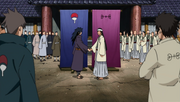| This article is about the time period. For the episode, see Warring States Period. |

The many mercenary clans active during this era.
The Warring States Period (戦国時代, Sengoku Jidai) was the long, violent era preceding the formation of the hidden villages.
History[]

A child sent to the battlefield.
During the Warring States Period, the countries of the world were uniformly small, constantly battling each other for land, power, and opportunity. To fight these battles, countries hired one or more clans of mercenary shinobi to represent their interests, the shinobi's loyalties ultimately going to the highest bidder.[1] The constant warfare in turn led to constant death, creating an average lifespan of only thirty years. Children were the greatest victims of the era, forced to fight for their clan no differently than an adult would and, more often than not, being killed by older and more skilled opponents.[2] In an attempt to avoid conflict caused by the ever-changing alliances and resulting vendettas, shinobi were in the habit of never divulging their family names to strangers.[3]

The Uchiha vs. the Senju.
Amidst all the vying for supremacy, two clans emerged as the strongest: the Senju clan, famed for their balanced skill in all the shinobi arts, and the Uchiha clan, famed for their Sharingan. Whenever one side in a conflict hired one of the clans, the opposing side would hire the other clan. This constant competition created a deep-seated animosity between its members, with all Senju having lost a loved one to an Uchiha and vice versa. Despite the clans' enmity, it would be the Senju and Uchiha that brought an end to the Warring States Period. Hashirama Senju and Madara Uchiha met as children, unaware of each other's identity. They quickly became friends, bonding over the deaths of their brothers, their desire to protect their remaining siblings, and their dreams of a peaceful world where children wouldn't need to fight.
Hashirama and Madara eventually learned who the other was, preventing them from continuing to meet under friendly circumstances. Over the following years, the two regularly met and fought on the battlefield, with each in time becoming the leader of his respective clan. Hashirama attempted to use their new positions to broker peace between their clans at long last, finally achieving the dreams they'd had as children. Although Madara was tempted, the death of his last remaining brother, Izuna, committed him to continuing the fight. Other Uchiha, however, found the prospect of peace tempting and started surrendering to the Senju in growing numbers. With his support running out, Madara made a last stand against Hashirama and the Senju and was summarily defeated.[4] From his defeat and Hashirama's willingness to give his own life to stop the bloodshed, Madara was convinced to accept the peace proposal.

The Senju and Uchiha form an alliance.
The allied Senju and Uchiha formed a pact with the Land of Fire to allow them to establish a shinobi village within its borders, what would be called Konohagakure. Other clans wishing to share in the new peace settled in Konoha as well, the Shimura and Sarutobi clans being amongst the first. Other clans in other countries, either out of inspiration that the once bitter enemies; the Uchiha and the Senju were able to put their differences aside and formed an alliance or out of fear of the combined might of their clans, or a combination of both, created their own villages. Thus was the Warring States Period brought to an end, replaced by the Shinobi Organisational System of the Five Great Shinobi Countries.[5]
Influence[]
The Warring States Period (戦国時代, Sengoku Jidai) was a timespan of two centuries where the Ashikaga Shogunate collapsed and Japan was torn into various factions in the midst of a bloody civil war. This moment in history was the time of many famous ninja such as Fūma Kotarō. It was also an era where shinobi were in high demand for unconventional tactics such as infiltration, espionage, assassination, and sabotage. But after the war resolved in 1615 with the establishment of the Tokugawa Shogunate, their services were cut in a united Japan and ninja began to fade into history.
The Warring States Period (simplified Chinese: 战国时代; traditional Chinese: 戰國時代; pinyin: Zhànguó Shídài) was also timespan of three centuries in Chinese History where the Zhou Dynasty was extinguished and the Chinese Empire split in to various warring city-states. It followed the Spring and Autumn period and concluded with the victory of the state of Qin in 221 BC; creating a unified China under the Qin Dynasty.
